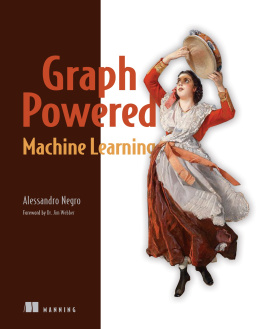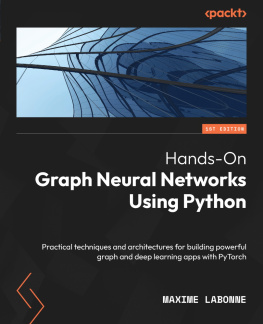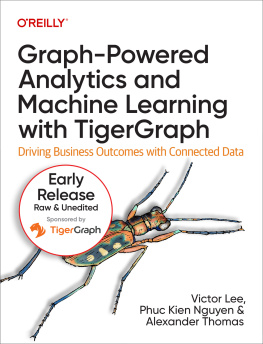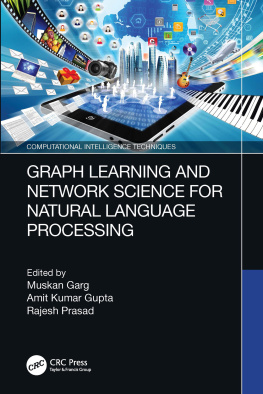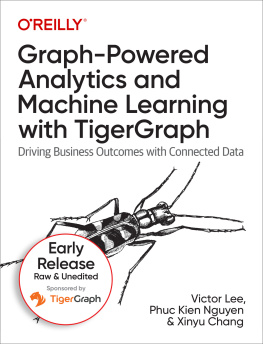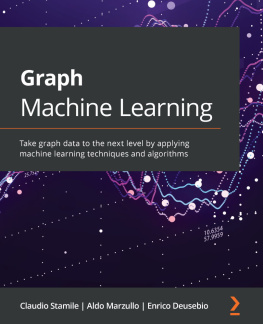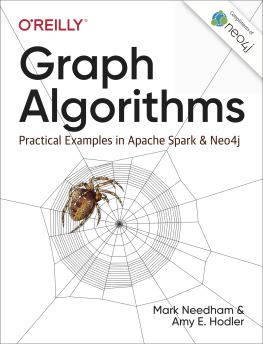Alessandro Negro - Graph-Powered Machine Learning
Here you can read online Alessandro Negro - Graph-Powered Machine Learning full text of the book (entire story) in english for free. Download pdf and epub, get meaning, cover and reviews about this ebook. year: 2021, publisher: Manning Publications, genre: Romance novel. Description of the work, (preface) as well as reviews are available. Best literature library LitArk.com created for fans of good reading and offers a wide selection of genres:
Romance novel
Science fiction
Adventure
Detective
Science
History
Home and family
Prose
Art
Politics
Computer
Non-fiction
Religion
Business
Children
Humor
Choose a favorite category and find really read worthwhile books. Enjoy immersion in the world of imagination, feel the emotions of the characters or learn something new for yourself, make an fascinating discovery.
- Book:Graph-Powered Machine Learning
- Author:
- Publisher:Manning Publications
- Genre:
- Year:2021
- Rating:5 / 5
- Favourites:Add to favourites
- Your mark:
- 100
- 1
- 2
- 3
- 4
- 5
Graph-Powered Machine Learning: summary, description and annotation
We offer to read an annotation, description, summary or preface (depends on what the author of the book "Graph-Powered Machine Learning" wrote himself). If you haven't found the necessary information about the book — write in the comments, we will try to find it.
Graph-Powered Machine Learning — read online for free the complete book (whole text) full work
Below is the text of the book, divided by pages. System saving the place of the last page read, allows you to conveniently read the book "Graph-Powered Machine Learning" online for free, without having to search again every time where you left off. Put a bookmark, and you can go to the page where you finished reading at any time.
Font size:
Interval:
Bookmark:

Alessandro Negro
Foreword by Dr. Jim Webber
To comment go to liveBook

Manning
Shelter Island
For more information on this and other Manning titles go to
www.manning.com
For online information and ordering of these and other Manning books, please visit www.manning.com. The publisher offers discounts on these books when ordered in quantity.
For more information, please contact
Special Sales Department
Manning Publications Co.
20 Baldwin Road
PO Box 761
Shelter Island, NY 11964
Email: orders@manning.com
2021 by Manning Publications Co. All rights reserved.
No part of this publication may be reproduced, stored in a retrieval system, or transmitted, in any form or by means electronic, mechanical, photocopying, or otherwise, without prior written permission of the publisher.
Many of the designations used by manufacturers and sellers to distinguish their products are claimed as trademarks. Where those designations appear in the book, and Manning Publications was aware of a trademark claim, the designations have been printed in initial caps or all caps.
Recognizing the importance of preserving what has been written, it is Mannings policy to have the books we publish printed on acid-free paper, and we exert our best efforts to that end. Recognizing also our responsibility to conserve the resources of our planet, Manning books are printed on paper that is at least 15 percent recycled and processed without the use of elemental chlorine.
| Manning Publications Co. 20 Baldwin Road Technical PO Box 761 Shelter Island, NY 11964 |
Development editor: | Dustin Archibald |
Technical development editors: | Michiel Trimpe & Al Krinker |
Review editor: | Ivan Martinovi |
Production editor: | Andy Marinkovich |
Copy editor: | Keir Simpson |
Proofreader: | Katie Tennant |
Technical proofreader: | Alex Ott |
Typesetter: | Gordan Salinovi |
Cover designer: | Marija Tudor |
ISBN: 9781617295645
To Filippo and Flavia: I hope you are as proud of your father as I am always proud of you.
The technology world is abuzz with machine learning. Every day we are bombarded with articles on its applications and advances. But there is a quiet revolution brewing among practitioners, and that revolution puts graphs at the very heart of machine learning.
Alessandro wrote this book after almost a decade of practice, at the confluence of graphs and machine learning. Had Alessandro worked for one of the Web giants distilling the knowledge of an army of PhDs working on special one-off systems, this would be an interesting book, but for the majority of us it would satisfy our curiosity rather than being a practical guide. Fortunately for us, while Alessandro does have a PhD, he works in the enterprise space and has deep empathy and understanding for the kinds of systems that enterprises build. The book reflects this: Alessandro ably addresses the kinds of practical design and implementation challenges that software engineers and data professionals building contemporary systems outside of the hyperscale Web giants must circumvent.
Graph-Powered Machine Learning demonstrates how important graphs are to the future of machine learning. It shows not only that graphs provide a superior means of fuelling contemporary ML pipelines, but also how graphs are a natural way of organizing, analyzing, and processing data for machine learning. The book offers a rich, curated tour of graph machine learning, and each topic is underpinned with detailed examples drawing on Alessandros deep experience and the easy, refined confidence of a long-term practitioner.
The book eases us in, providing an overall framework to reason about machine learning and integrate it into our data systems. It follows up immediately with a practical approach to recommendations covering a variety of approaches, such as collaborative filtering, content- and session-based recommendations, and hybrid styles. Alessandro calls out the problems which lack explainability in state-of-the-art techniques and shows that this isnt an issue with the graph approach. He then continues to tackle fraud detection, taking in concepts like proximity and social network analysis, where we relearn the maxim that birds of a feather flock together in the context of criminal networks. Finally, the book deals with knowledge graphs: the ability of graph technology to consume documents and distil connected knowledge from them, disambiguate terms, and handle ambiguous query terms. The breadth of topics is vast, but the quality of information is always excellent.
Throughout the book, Alessandro gently guides the reader, building up from the basics to advanced concepts. With the examples and companion code, practically minded readers are able to get examples working quickly, and from there to adapt them for their own needs. You will finish this book armed with a variety of practical tools at your disposal and, if you like, some dirt under your fingernails. You will be ready to extract graph features to make your existing models perform better today, and youll be equipped to work natively with graphs tomorrow. I promise its going to be a wonderful journey.
Dr. Jim Webber, Chief Scientist @ Neo4j
The summer of 2012 was one of the warmest I can remember in southern Italy. My wife and I were awaiting our first son, who was going to be delivered quite soon, so we had few chances to go out or take any refreshment in the awesomely fresh, clean water of Apulia. Under those conditions, you can get crazy with DIY (not my case), or you can keep your mind busy with something challenging. Because Im not a great fan of Sudoku, I started working on a night and weekend project: attempting to build a generic recommendation engine that could serve multiple scopes and scenarios, from small and simple to complex and articulated datasets of user-item interactions, eventually with related contextual information.
This was the moment when graphs forcefully entered my life. Such a flexible data model allowed me to store in the same way not only the users purchases, but also all the corollary information (later formally defined as contextual information) together with the resulting recommendation model. At that time, Neo4j 1.x was recently released. Although it didnt have Cypher or the other advanced query mechanisms it has now, it was stable enough for me to select it as the main graph database for my project. Adopting graphs helped me unblock the project, and after four months, I released the alpha version of reco4j: the first graph-powered recommendation engine in history!
It was the beginning of a true and passionate love story. For three years, I experimented on my own, trying to sell the reco4j idea here and there (not so successfully, to be honest) when I had a call with Michal Bachman, CEO of GraphAware. A few days later, I flew to London to sign my contract as the sixth employee of this small consultancy firm, which helped companies succeed in their graph projects. Finally, graphs had become my raison detre (after my two children, of course ).
Font size:
Interval:
Bookmark:
Similar books «Graph-Powered Machine Learning»
Look at similar books to Graph-Powered Machine Learning. We have selected literature similar in name and meaning in the hope of providing readers with more options to find new, interesting, not yet read works.
Discussion, reviews of the book Graph-Powered Machine Learning and just readers' own opinions. Leave your comments, write what you think about the work, its meaning or the main characters. Specify what exactly you liked and what you didn't like, and why you think so.

